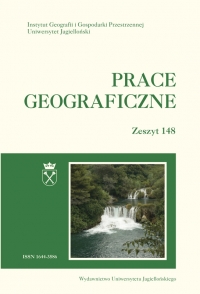Miesięczne anomalie termiczne na Alasce (1951–2015)
Monthly air temperature anomalies in Alaska (1951–2015)
Author(s): Agnieszka SulikowskaSubject(s): Environmental Geography, Applied Geography
Published by: Wydawnictwo Uniwersytetu Jagiellońskiego
Keywords: thermal anomaly; Pacific Decadal Oscillation; Alaska
Summary/Abstract: The aim of this paper is to present both anomalously warm months ( AWM ) and anomalously cold months ( ACM ) in Alaska and to refine the linkage of Pacific Decadal Oscillation ( PDO ) with their occurrence. The study is based on mean monthly temperature data from 15 weather stations located in Alaska recorded during the period of 1951–2015. The anomalous months were defined as having an average temperature different from the long-term mean by at least 2 standard deviations. Temporal variability, spatial extent and temperature magnitude of AWM and ACM were characterized. In total ( considering all 15 stations ), there were 243 cases of AWM and 298 cases of ACM, which occurred during 100 and 123 months of the 65-year period respectively. AWM occurred most frequently in January and from June to August while ACM from February to April and in November and December. To some degree months with the biggest number of AWM were the same as months with the smallest number of ACM and vice versa. This indicates that during particular months synoptic and/or local conditions may be more favourable for the occurrence of positive or negative anomalies. Both AWM and ACM covered from 1 to 11 weather stations simultaneously, though the majority of the anomalous months of each type were observed at single stations or at two neighboring stations. Generally, the scale of the anomaly tended to be larger during ACM than AWM ( i.e. down to –17,0°C compared to maximum 15,6°C for AWM ), during winter than summer, and in the central part of Alaska than at the seaside. There is a clearly visible increase in the frequency of AWM and a decrease in the frequency of ACM after 1976 when PDO shifted from dominantly negative to positive values. Comparing two periods, 1951–1976 and 1977–2015, one can notice that in the latter the mean annual number of ACM in Alaska decreased by one-third and the mean annual number of AWM doubled. The spatial extent of ACM was also considerably smaller ( on average ) and of AWM – larger. In total about 80% of AWM ( ACM ) occurred during the positive ( negative ) values of PDO index. Monthly temperature anomalies in Alaska are mainly driven by atmospheric circulation patterns. AWM coincide with advection of warm air masses from the south while ACM tend to occur in association with northern cold advections. Local effects, which include radiative cooling, temperature inversions and local winds ( i.e. chinook ), also have a great contribution to the occurrence of anomalous months in Alaska.
Journal: Prace Geograficzne
- Issue Year: 2017
- Issue No: 148
- Page Range: 33-54
- Page Count: 22
- Language: Polish

